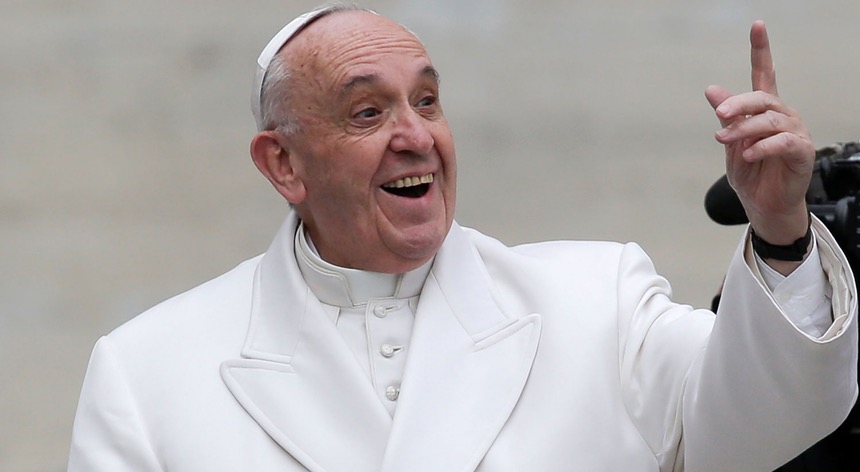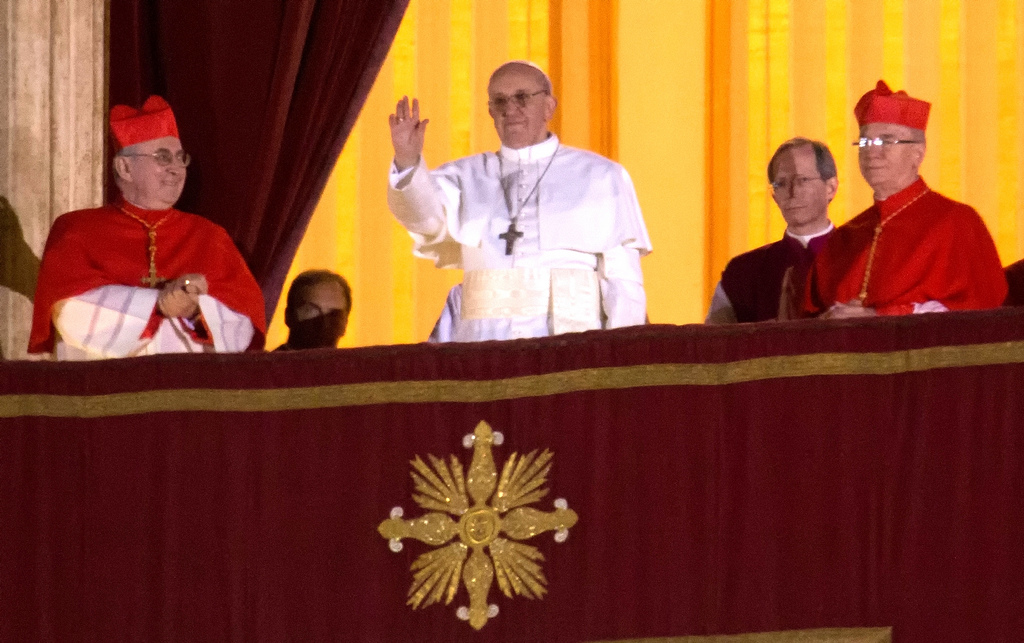
Francis, the pope who came from the ends of the earth
Pope Francis Biography
Pope Francis comes to Fatima four years and three months after the cardinals gathered in the conclave have gone to “the ends of the earth” to get him, as he mentioned in his first message directed to the faithful, from the central loggia of Saint Peter’s Basilica, on May 13th, 2013.
Cardinal Jorge Bergoglio, first Jesuit to sit on Saint Peter’s chair, first Latin American Pope, first non-European Pope in nearly 1200 years, chose Francis as his papal name in honor of Saint Francis of Assisi, inspired by his “simplicity and dedication to poor”.
Popularity never seen before
Since then, he has been following faithfully those inspiring principles, nurturing a popularity never seen before, mostly among the non-believers, among those who are perplexed by the simplicity of attitudes and gestures of a Pope who has privileged the pastoral and apostolic action near the suburbs, near of those who most need support and kindness.
Francis is making the difference with changes of attitudes and behaviors within the Roman Curia: it goes from the choice of Saint Martha's House for his home, where he celebrates daily and has his meals with the other residents, leaving behind the Apostolic Palace, to his frequent outings, or other so simple or unexpected gestures such as the purchase of shoes or glasses. These changes have echoed positively among media.
A Pope who makes his own phone calls, who pays his stay in Domus Paulus XVI, where he stayed during the conclave that elected him, and he doesn’t hide his love for football nor his love for his club (San Lorenzo de Almagro, Argentina) of which he is a supporter.
Election four years ago
 Francis, who just turned 80, was elected the successor of Benedict XVI on March 13th, 2013, after the resignation of the now Emeritus Pope. Francis, who just turned 80, was elected the successor of Benedict XVI on March 13th, 2013, after the resignation of the now Emeritus Pope.
Appearing on the balcony of the Basilica, he asked the faithful gathered in Saint Peter’s Square, in Rome, to pray for him before wishing “Good night. Good rest”: “And now I would like to give the blessing, but first - first I ask a favor of you: before the Bishop blesses his people, I ask you to pray to the Lord that he will bless me: the prayer of the people asking the blessing for their Bishop. Let us make, in silence, this prayer: your prayer over me”.
Visits
He has already visited four continents and made some symbolic journeys, including a visit to Lampedusa, in Italy, and the Isle of Lesbos, in Greece, both places of welcome of refugees and migrants who cross the Mediterranean, and a visit to the concentration camp of Auschwitz, in Poland, among other visits to countries, regions and parishes in the diocese of Rome.
Philippines have welcomed, on January 18th, 2015, the greatest celebration of the current pontificate, near the Quirino Grandstand stadium, in the Rizal Park area, with six million participants, which represents a record in Catholic Church.
Apostolic action and reform of the Cúria
Among the main documents of the current pontificate, there are the encyclicals “Laudato si” (Praised Be You) dedicated to ecological issues, and “Lumen fidei” (The light of faith), which gathers reflections of Benedict XVI, the apostolic exhortation “Evangelii gaudium” (The joy of the Gospel) and the post-synodal “Amoris Laetitia” (The joy of Love).
The Argentinian Pope promoted a Synod about family, in two sessions, with appointments extended to the catholic communities, and announced an Extraordinary Holy Year, the Jubilee of Mercy, 50 years after the closure of Vatican Council II.
He is, on the other side, developing a renovation of the Roman Curia, starting with the financial and administrative sector, with external audits to the Vatican accounts, and the creation of a Secretariat for the Economy of the Holy See, plus the implementation of financial transparency measures in the Institute for the Works for Religion (IOR, known as the Vatican Bank)
Besides the several critics to an economic and financial system that “kills”, the Pope has appealing to peace in the many regions of the world affected by conflicts, standing for the Christians in the Middle East, persecuted by the self-proclaimed Islamic State and criticizing those who justify terrorist attacks using religious convictions.
The Pope has already promoted three consistories and named 57 new cardinals, including Monsignor Manuel Clemente, patriarch-cardinal of Lisbon
Since the first moment, he consecrated his pontificate to Our Lady. Known to be a profoundly Marian Pope, Francis has surprised the world. Even the most critical media has praised him. The Rolling Stone magazine elected him as the “Cool Pope”, and Time magazine as the personality of the year.
“My people is poor and I am one of them”, he said several times, to explain some of his choice mostly when he was archbishop of Buenos Aires.
To his priests, he recommended mercy, apostolic courage and open doors to all. The worst thing that can happen in the Church, he explained in some circumstances, “is the spiritual mundaneness”, which means “to be self-centered”.
And, when he speaks of social justice, he invites first of all to take again the catechism in hands, to rediscover the Ten Commandments and the beatitudes. His program is simple: “if you follow Christ, we will understand that trampling upon a person’s dignity is a serious sin”.
Argentinian of italian descendent
He was born in the Argentinian capital on December 17th, 1936, and he is the son of Italian immigrants of the region of Piedmont: his father, Mario, worked as an accountant employed by the railroad; his mother, Regina Sivori, was a housewife taking care of the house and the education of their five children.
He graduated as a chemical technician, and after that chose the priesthood path, entering the diocesan seminary of Villa Devoto. On March 11th, 1958, he entered the novitiate of the Society of Jesus. He completed his studies of humanities in Chile and, returned to Argentina, in 1963 to graduate with a degree in Philosophy from the college Saint Joseph, in San Miguel.
From 1964 to 1965, he taught Literature and Psychology in the college of the Immaculate in Santa Fé, and in 166 taught these same subjects in the college del Salvador, in Buenos Aires. From 1967 to 1970 he studied Theology and obtained a degree from the Saint Joseph college.
Priest, Archebishop, Cardinal, Pope
On December 13th, 1969, he was ordained a priest by archbishop Ramón José Castellano. From 1970 to 1971, he continued his training in Alcalá de Henares, Spain, and on April 23rd, 1973, he made his perpetual profession with the Jesuits.
He returned to Argentina where he was novice master at Villa Barilari, San Miguel, professor at the Faculty of Theology, consultor to the Province of the Society of Jesus and Rector of the college
On July 31st, 1973, he was appointed Provincial of the Jesuits in Argentina, an office he held for six years. He then restarted his work in the university sector and from 1980 to 1986 served once again as Rector of the college of San José, as well as parish priest, again in San Miguel.
In March 1986, he went to Germany to finish his doctoral thesis; his superiors then sent him to the College del Salvador in Buenos Aires and then to the Jesuit Church in the city of Córdoba as spiritual director and confessor.
On February 28th, 1998, he became archbishop of Bueno Aires (until his election of Pope), and three years later, on February 21st, 2001, he was created cardinal by Saint John Paul II.
He participated in the two conclaves: in 2005 that elected Cardinal Joseph Ratzinger as Pope, and in 2013, in which he was elected Pope on March 13th, following the resignation of Benedict XVI.
|